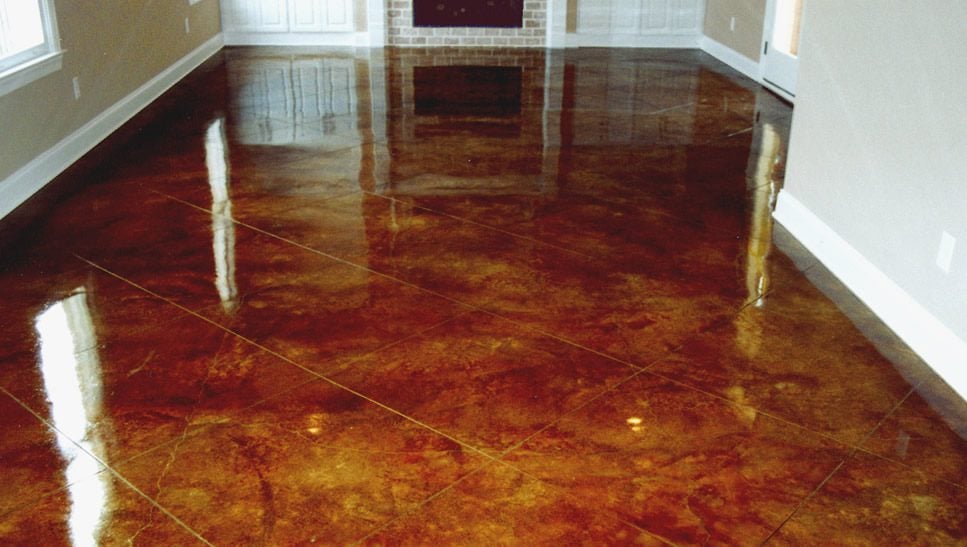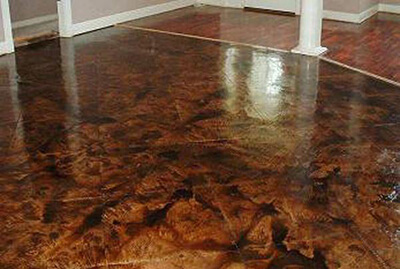Recognizing the Various Types of Stained Concrete for Your Following Job
Stained concrete deals different choices that cater to different visual and practical demands. Each type presents unique attributes that affect the final look and resilience of the surface. Understanding these distinctions is crucial for any person planning a task. From abundant, chemical responses of acid-based stains to the dynamic harmony of strong shade stains, the selections can considerably affect the result. What factors should one consider when choosing the optimal discolor for their details requirements?
Overview of Stained Concrete
Stained concrete functions as a functional floor covering alternative that can improve the visual appeal of different areas. This strategy involves applying a tinting representative to the surface of existing concrete, permitting for a wide spectrum of layout opportunities. Stained concrete is prominent in both domestic and commercial atmospheres, providing a durable and low-maintenance remedy that can simulate the look of all-natural materials like stone or ceramic tile.
The staining process can be performed utilizing water-based or solvent-based items, each providing distinct aesthetic results. The final look is influenced by aspects such as the original concrete surface, the kind of discolor used, and the application method. Stained concrete not just improves exterior and interiors but likewise promotes sustainability by rejuvenating existing concrete structures. Because of this, it has acquired grip among property owners and designers seeking both capability and design in their floor covering choices.
Acid-Based Stains: Qualities and Benefits

One-of-a-kind Color Variants
Concrete surfaces can transform significantly with the application of acid-based stains, which use a rich palette of one-of-a-kind shade variations. These stains pass through the concrete, reacting chemically to generate lively planet tones that range from deep browns and reds to soft greens and blues. The resulting colors are often variegated, creating an all-natural, marble-like appearance that enhances the concrete's personality. Each application yields distinct results as a result of variations in the concrete's make-up and the discoloration technique made use of, making every task unique. Furthermore, acid-based stains can be layered or integrated with other strategies to create customized layouts, permitting personal expression. This adaptability makes acid-based stains a prominent choice for both residential and business applications.
Chain Reaction Discussed
While many factors contribute to the efficiency of acid-based stains, the underlying chemical reactions play a necessary duty in their distinct qualities and benefits. These stains mostly contain water, acid, and metal salts. When put on concrete, the acid reacts with the calcium hydroxide in the cement, developing a chemical transformation that causes long-term color modifications. The metal salts pass through the surface area and bond with the concrete, enabling a large range of tones and tones. This response not only boosts visual appeal but likewise gives toughness, making the color immune to fading and wear. In addition, acid-based stains can create a variegated finish that simulates natural stone, more enhancing their popularity for attractive concrete applications.
Surface Area Preparation Relevance
Accomplishing suitable results with acid-based stains rests on comprehensive surface preparation. This crucial action warranties that the concrete surface area is clean, cost-free of pollutants, and properly profiled for optimal discolor absorption. Any existing sealants, dust, or oils can prevent the chemical reaction that creates the wanted color and surface, causing irregular or patchy results.
Before applying the stain, the concrete must be mechanically cleaned up or pressure cleaned, complied with by a thorough assessment for cracks or imperfections that may require repair work. In addition, confirming the surface is properly dried will boost stain adherence. By focusing on these primary procedures, the long life and vibrancy of acid-based stains can be significantly enhanced, leading to an extra aesthetically pleasing and durable coating.
Water-Based Stains: Attributes and Advantages

Water-based stains pass through the concrete, using an extra transparent surface that highlights the natural appearance and variations of the surface area below. They are offered in a wide variety of shades, permitting innovative flexibility in layout. In addition, water-based stains are less complicated to tidy up, needing just water and soap, which simplifies the application procedure.
Their fast drying out time enhances performance, making them a sensible selection for both DIY lovers and experts. Overall, water-based stains provide an attractive mix of aesthetic convenience and easy to use buildings, making them a prominent option for concrete enhancement jobs.
Strong Color Stains: Vibrant Alternatives for a Bold Look
Strong color stains use an efficient option for those looking for to produce a strong and lively visual on concrete surface areas. These stains give an uniform pigmentation that can substantially enhance the aesthetic allure of floors, patio areas, and driveways. Readily available in a wide range of shades, strong shade stains enable imaginative expression, satisfying different design preferences.
One of the vital advantages of strong color stains is their ability to conceal blemishes, offering a fresh and sleek appearance to aging concrete - Stained Concrete Floors Austin moved here Texas. Furthermore, their formula normally includes UV-resistant residential or commercial properties, guaranteeing long life and color retention even in rough weather condition conditions
Application is simple, requiring minimal preparation of the concrete surface area. As soon as applied, strong shade stains can be sealed for added defense and shine, more raising their visual quality. With their dynamic choices, strong color stains are an excellent selection for those going for an impactful and cohesive style.
Semi-Transparent Stains: Accomplishing Depth and Measurement
Semi-transparent stains provide a special technique to improving concrete surfaces by offering depth and measurement through numerous shade choices. Understanding the application methods is essential for achieving the wanted result, while appropriate upkeep techniques assure durability. This section will certainly check out these vital aspects to make the most of the advantages of semi-transparent staining.
Color Options Available
A wide range of color options exists for semi-transparent stains, permitting house owners and designers to boost the all-natural appeal of concrete surfaces. These stains can be found in a variety of hues, from earthy tones like browns and terracottas to lively colors such as blues and environment-friendlies. The semi-transparent nature of these stains enables the underlying concrete to reveal with, producing a distinct deepness and dimension that can match various layout aesthetic appeals. Additionally, combining various colors can generate personalized tones, enabling a tailored seek each task. This adaptability makes semi-transparent stains a preferred selection for both exterior and interior applications, as they can integrate with surrounding aspects while adding aesthetic rate of interest to simple concrete.
Application Methods Clarified
To achieve the preferred deepness and dimension with semi-transparent stains, correct application techniques are vital. Surface area preparation is critical; the concrete needs to be clean and free of any kind of contaminants. This typically includes power washing and repairing any type of fractures. Next off, choosing the appropriate applicator, such as a sprayer, roller, or brush, can influence the final look. Sprayers enable a more even application, while rollers can aid attain texture. It is essential to use the tarnish in slim, even layers, permitting each layer to dry prior to adding an additional. Adjusting the application technique, such as varying pressure or utilizing various tools, can create one-of-a-kind impacts. Lastly, securing the stained surface area boosts the vibrancy of the colors while giving defense.
Upkeep Ideal Practices
Routine maintenance is essential for maintaining the beauty and honesty of surfaces treated with semi-transparent stains. To preserve these surface areas, routine cleansing is vital. Making use of a pH-neutral cleaner and a soft-bristle mop will certainly help remove dirt and particles without damaging the stain. It is a good idea to stay clear of severe chemicals, as they can deteriorate the tarnish's appearance. Additionally, regular resealing each to three years can secure versus wear and fading. This process involves cleansing the surface area extensively and using a compatible sealant developed for stained concrete. Homeowners need to also check for any kind of indications of staining or damage and address these issues promptly to ensure long-lasting vibrancy and resilience. Adhering to these finest techniques will improve the general lifespan of semi-transparent stained surface areas.
Effects and Methods: Tailoring Your Stained Concrete
Customizing stained concrete entails a variety of techniques that boost both aesthetics and functionality. Amongst these approaches, layering different discolor shades can develop deepness and intricacy, enabling distinct visual results. Strategies such as acid staining offer a variegated look, while water-based stains supply a more uniform look.
Furthermore, including attractive patterns, such as stenciling or inscription, can better personalize the surface area, including complex styles that deal with private tastes. Texturing the concrete, whether with stamping or broom coatings, introduces responsive elements that not only enhance hold however additionally enhance visual interest.
Using sealers can intensify the color vibrancy and supply security versus wear. Customization strategies expand beyond simple shade; they can transform a standard concrete slab right into a sensational centerpiece, making it appropriate for both household and business spaces. Via cautious choice of results and methods, stained concrete can achieve a really tailored look.
Upkeep and Longevity of Stained Surfaces
Although stained concrete surfaces are understood for their sturdiness check and aesthetic allure, maintaining their integrity is important for making sure longevity. Regular cleaning is vital; sweeping and mopping with a pH-neutral cleaner assists protect against dust build-up and discoloration. Furthermore, applying a sealant every couple of years can safeguard the surface from wetness, chemicals, and UV damage, thereby enhancing its life expectancy.
It is also important to deal with any kind of splits or chips without delay. Tiny repair work can reduce more deterioration, protecting the aesthetic and structural high quality of the surface. For exterior stained concrete, seasonal maintenance, such as eliminating snow and ice, is needed to avoid surface damage from freeze-thaw cycles.
Often Asked Inquiries
Can I Tarnish Existing Concrete Surfaces or New Ones?
The inquiry of whether existing concrete surface areas can be stained occurs regularly. It is without a doubt feasible to discolor both new and old concrete, supplied the surface area is sufficiently prepared and without contaminants for perfect bond.
For how long Does the Staining Refine Usually Take?
The discoloration process usually takes one to three days, relying on variables such as surface prep work, kind of tarnish, and weather conditions. look at this site Austin Stained Concrete Floors. Treating time might prolong past preliminary application, influencing the total duration considerably
Is Stained Concrete Safe for Outdoor Use?
Stained concrete is typically secure for outdoor use, provided it is properly sealed. This securing secures against wetness and UV damages, guaranteeing sturdiness and safety, while additionally enhancing the aesthetic charm of outside spaces.
Can I Use Several Stain Layers for Various Impacts?
Using numerous tarnish layers can achieve varied impacts on stained concrete. However, it is vital to ensure compatibility between stains and allow appropriate drying time between applications to prevent unintended responses or discoloration.
Are There Any Type Of Shade Limitations for Stained Concrete?
Color limitations for stained concrete mostly depend upon the type of stain utilized, with water-based stains providing a more comprehensive scheme contrasted to acid-based stains. Stained Concrete Floors Austin Tx. Nevertheless, accomplishing vivid colors may call for cautious choice and application strategies